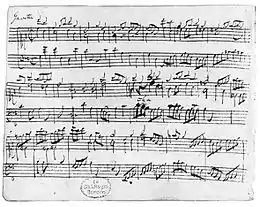French Suites (Bach)
The French Suites, BWV 812–817, are six suites which Johann Sebastian Bach wrote for the clavier (harpsichord or clavichord) between the years of 1722 and 1725.[1] Although Suites Nos. 1 to 4 are typically dated to 1722, it is possible that the first was written somewhat earlier.[1]

Style
The suites were later given the name 'French' (first recorded usage by Friedrich Wilhelm Marpurg in 1762). Likewise, the English Suites received a later appellation. The name was popularised by Bach's biographer Johann Nikolaus Forkel, who wrote in his 1802 biography of Bach, "One usually calls them French Suites because they are written in the French manner."[1] This claim, however, is inaccurate: like Bach's other suites, they follow a largely Italian convention.[2] There is no surviving definitive manuscript of these suites, and ornamentation varies both in type and in degree across manuscripts.[1] The courantes of the first (in D minor) and third (in B minor) suites are in the French style; the courantes of the other four suites are all in the Italian style. In any case, Bach also employed dance movements (such as the polonaise of the sixth suite) that are foreign to the French manner. Usually, the swift second movement after the allemande is named either courante (French style) or corrente (Italian style), but in all these suites the second movements are named courante, according to the Bach catalog listing, which supports the suggestion that these suites are "French". Some of the manuscripts that have come down to us are titled "Suites Pour Le Clavecin", which is what probably led to the tradition of calling them "French" Suites.
Two additional suites, one in A minor (BWV 818), the other in E♭ major (BWV 819), are linked to the familiar six in some manuscripts. The Overture in the French style, BWV 831, which Bach published as the second part of Clavier-Übung, is a suite in the French style but not connected to the French suites.[3] Some manuscripts have movements not found in other copies. These movements are probably spurious.
Movements
Suite No. 3 in B minor, BWV 814
- Allemande
- Courante
- Sarabande
- Angloise
- Menuet – Trio
- Gigue
Suite No. 4 in E♭ major, BWV 815
- Allemande
- Courante
- Sarabande
- Gavotte
- Air
- Menuet
- Gigue
Suite No. 4 also exists in an alternative version, published as BWV 815a, which includes three additional movements: a Prelude, a second Gavotte and a Menuet.[4][5]
Suite No. 5 in G major, BWV 816
The first few bars of this suite were written in 1722 for Bach's second wife, but it was not completed until 1723. The Gigue, as often, is in fugal style, in binary form. The voices enter in descending order (Soprano-Alto-Bass), while in the second half of the piece the voices not only enter in opposite order but also an inversion of the 1st subject.[6]
Suite No. 6 in E major, BWV 817
- Allemande
- Courante
- Sarabande
- Gavotte
- Polonaise
- Bourrée
- Menuet
- Gigue
Legacy
The Menuet from Suite No. 3 in B-minor BWV 814 was provided as one of three soundtrack options in Nintendo's Game Boy version of Tetris.[7]
See also
Notes and references
- Bach. The French Suites: Embellished version. Bärenreiter Urtext
- Christophe Rousset, notes to the recording of the French Suites, Ambroisie AMB9960
- Although see the discussion of French influences in Hans-Joachim Schulze, The French Influence in Bach's Instrumental Music, Early Music, 13:2, 1985 (J. S. Bach Tercentenary Issue, 180–184.
- Judith Schneider (1994). Johann Sebastian Bach: French Suites (2 ed.). Alfred Music. pp. 134–139. ISBN 978-1-4574-4464-7.
- David Schulenberg (2006). The Keyboard Music of J.S. Bach. New York: Routledge. ISBN 1-136-09154-8.
- O. Warburton, Annie. Analyses of Musical Classics, Book 1 (1963 ed.). Longmans. p. 27.
- Fifty Key Video Games Edited by Bernard Perron, Kelly Boudreau, Mark J.P. Wolf, Dominic Arsenault. Taylor and Francis, 2023.
External links
- French Suites: Scores at the International Music Score Library Project
- French Suites Archived 11 April 2021 at the Wayback Machine, Mutopia Project (free sheet music)
- Liner notes for recording by Angela Hewitt
- Liner notes Archived 11 April 2021 at the Wayback Machine for recording by Julian Perkins
- Liner notes Archived 3 September 2020 at the Wayback Machine for recording by Masaaki Suzuki